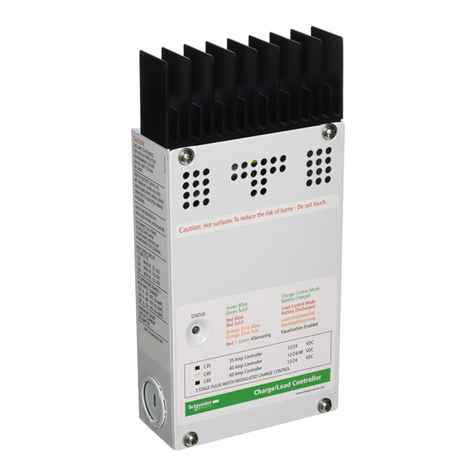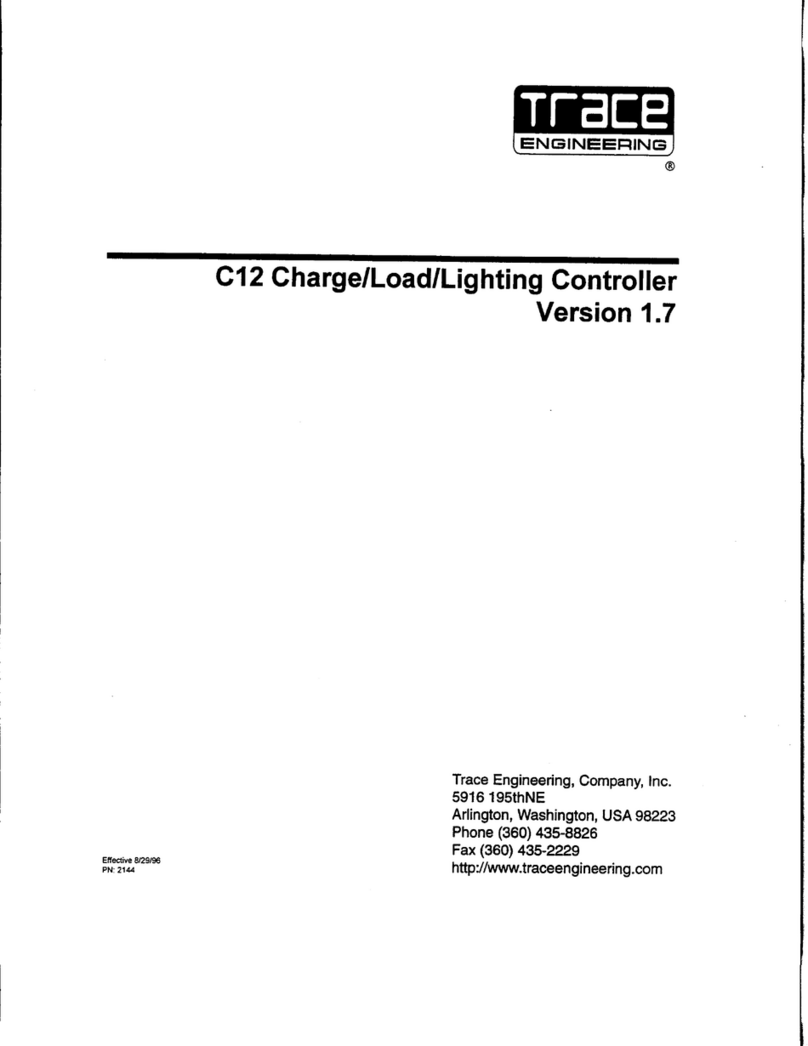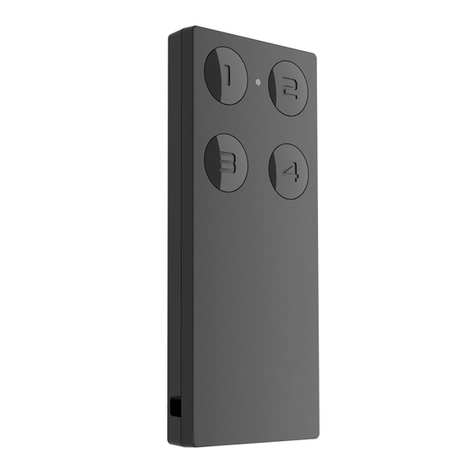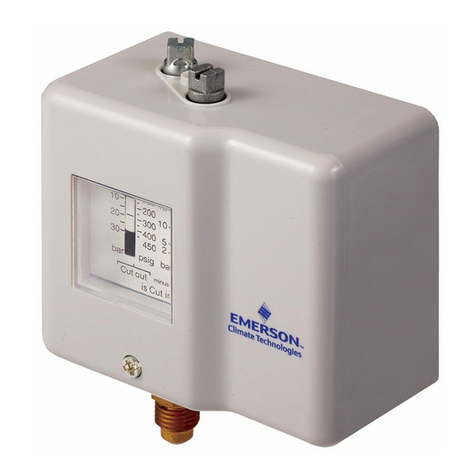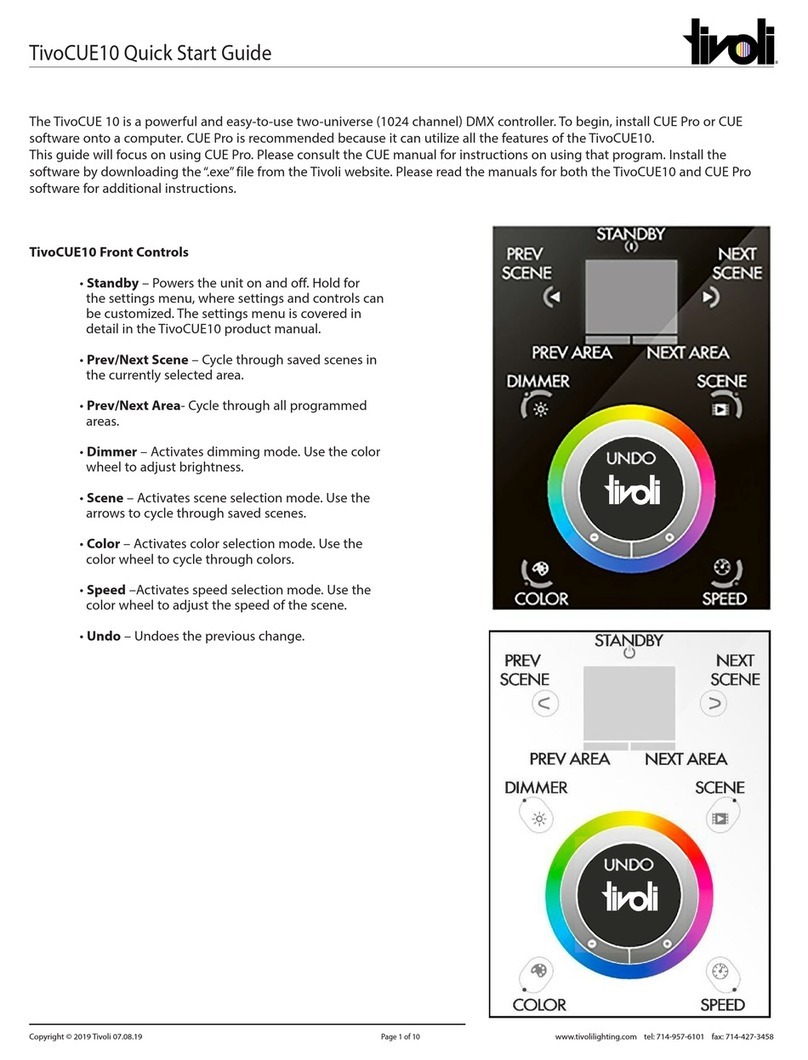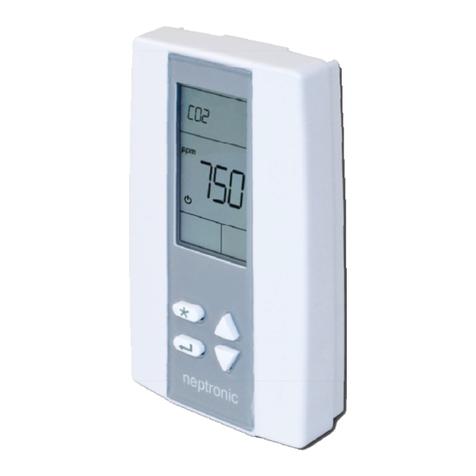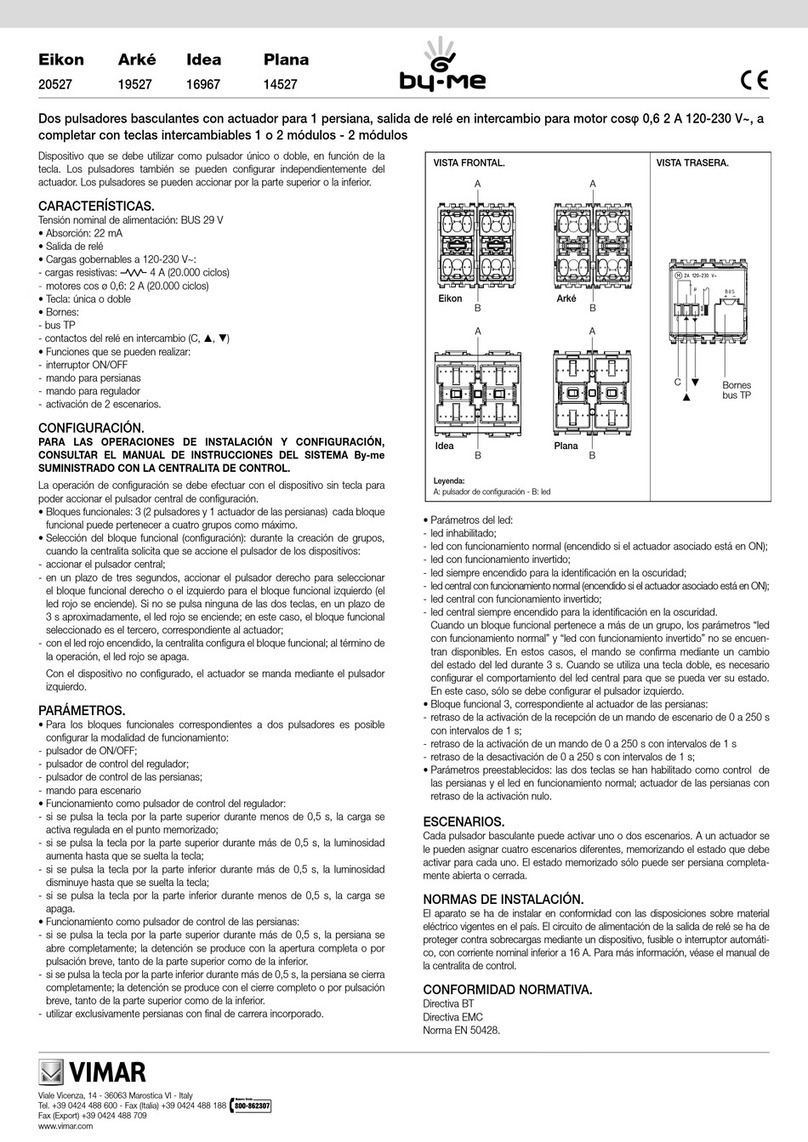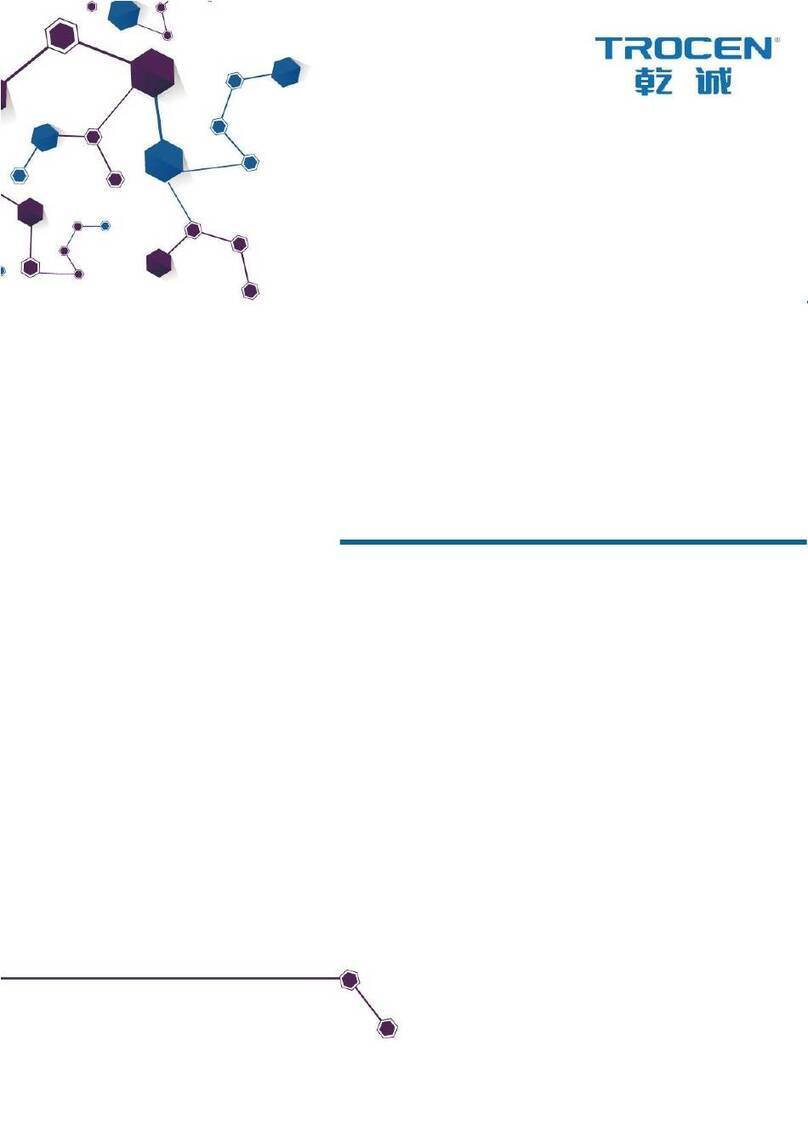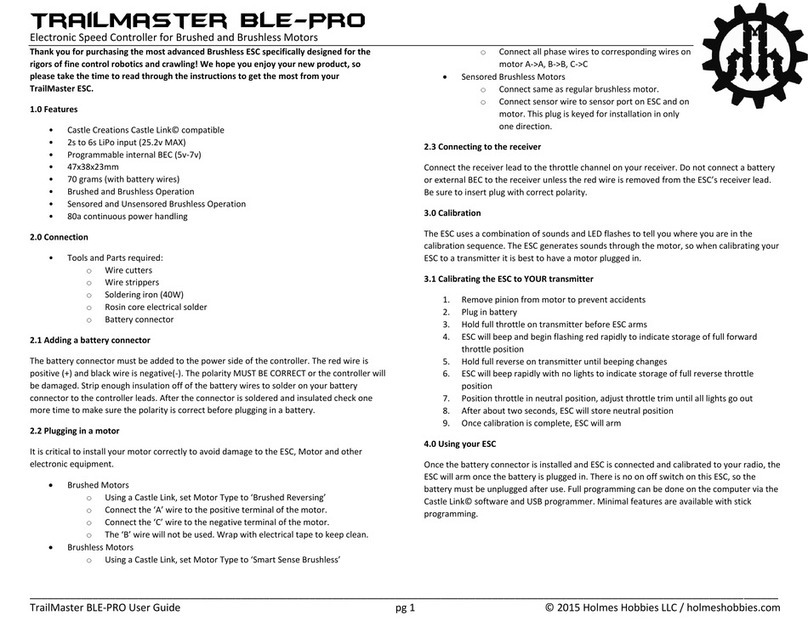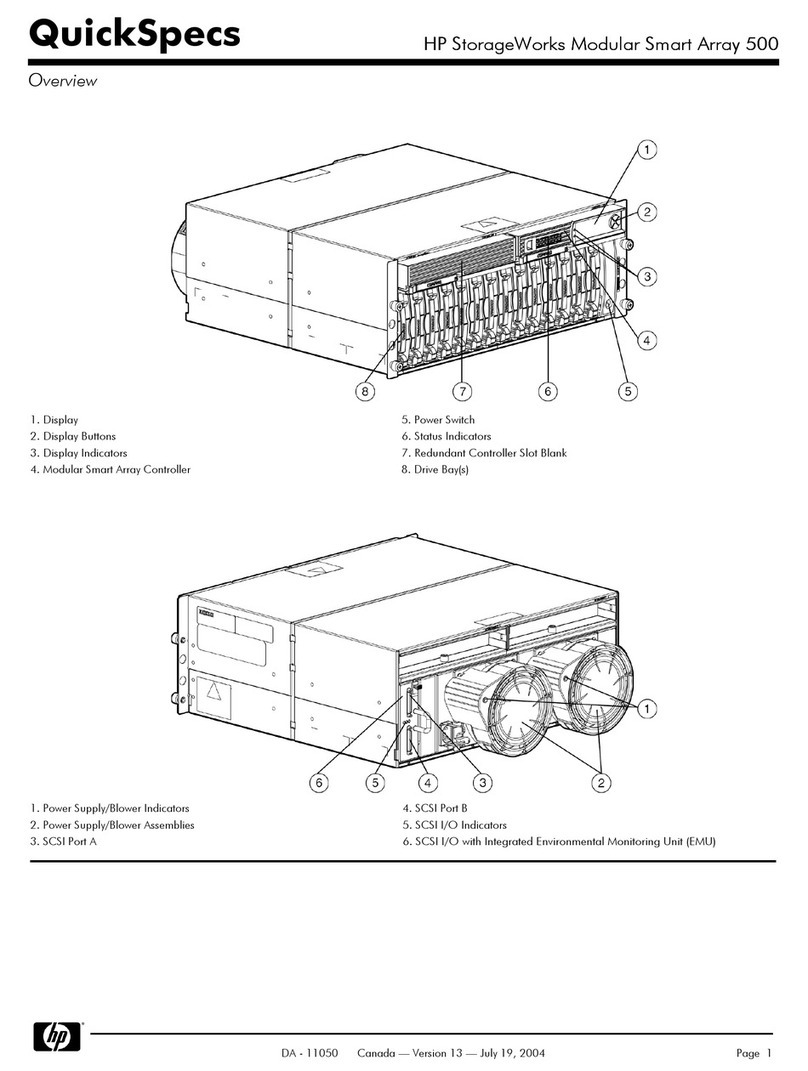Trace Engineering C35 - REV B User manual

Installation and Operation Guide
C-Series
Multifunction DC Controllers
©2000 Xantrex Technology Inc. P/N 975-0004-01-01 Rev. 11/00

©2000 Xantrex Technology Inc.

©2000 Xantrex Technology Inc.
Section Description Page
1. INTRODUCTION ............................................................. 1
Operating Modes
Photovoltaic Charge Control Mode
Automatic PV Array Night Disconnect
Diversion Control Mode
DC Load Control Mode
2. FEATURES ..................................................................... 5
Over-Temperature Protection
Electronic Over-Current Protection
attery Temperature Compensation
LED Status Indicator
Charge or Diversion Control Mode Indications
Solid Green
linking Green
Load Control Indications
Solid Red
linking Red
Slowing linking Orange
Equalization Mode Indication
Alternating Red and Green
Error Mode Indication
Fast linking Orange
3. INSTALLATION ............................................................... 10
Mounting
Wiring
Minimum Recommended Wire Size
Maximum One-way Distance and Wire Size
PV Charge Control Mode Cabling
Diversion Control Mode Cabling
DC Load Control Mode Cabling
Grounding
Configuring the C-Series
Automatic/Manual attery Equalization and
Low Voltage Reconnect
Operating Mode
Reset Switch
Voltage
C-Series
Multifunction DC Controllers
Table of Contents
i

©2000 Xantrex Technology Inc.
Section Description Page
3. INSTALLATION (continued)
Adjusting the C-Series
Setting Voltage Parameters
Testpoints for Voltage Settings
Equalization
Manual Equalization
Automatic Equalization
Temperature Compensation
Setting LVR and LVD (Load Control Mode)
Setting Diversion Control Mode
4. OPTIONS ........................................................................ 35
C-Series LCD Meter Displays
Installing the DVM/C40
Mounting the CM/R
5. OPERATION ................................................................... 38
Three-Stage attery Charging
ulk
Absorption
Float
Equalization
6. BATTERIES .................................................................... 41
Automotive atteries
Maintenance-Free atteries
Deep-Cycle atteries
Sealed atteries
NiCad and NiFe atteries
attery Sizing
8. DIVERSION LOADS ....................................................... 43
Charge Controller
Load Controller
Diversion Charge Controller
Diversion Load Types
9. SPECIFICATIONS .......................................................... 46
10. SERVICE INFORMATION .............................................. 47
11. WARRANTY .................................................................... 48
ii
Table of Contents (Continued)

©2000 Xantrex Technology Inc. iii
IMPORTANT SAFETY INSTRUCTIONS
This manual contains important safety instructions that should be
followed during the installation and maintenance of this product.
To reduce the risk of electrical shock, and to ensure the safe installation
and operation of this product, the following safety symbols have been placed
throughout this manual to indicate dangerous conditions and important safety
instructions.
WARNING - A dangerous voltage or condition exists in this area.
Use extreme caution when performing these tasks.
AVERTISSEMENT - Une tension ou condition dangereuse
existe dans cette zone. Faire preuve dextrême prudence lors de la
réalisation de ces tâches.
CAUTION - This procedure is critical to the safe installation or
operation of the unit. Follow these instructions closely.
ATTENTION - Cette procédure est essentielle à linstallation ou
lutilisation de lunité en toute sécurité. Suivre ces instructions de près.
NOTE - This statement is important. Follow instructions closely.
NOTE - Cette déclaration est importante. Suivre les instructions
deprès.
·All electrical work must be done in accordance with local, national, and/or
international electrical codes.
·efore installing or using this device, read all instructions and cautionary
markings located in (or on) the manual, the inverter, the controller, the
batteries, and the PV array.
·Do not expose this unit to rain, snow or liquids of any type. This product is
designed only for indoor mounting.
·To reduce the chance of short-circuits when installing or working with the
inverter, the controller, the batteries, or the PV array, use insulated tools.
·Remove all jewelry such as rings, bracelets, necklaces, etc., while
installing this system. This will greatly reduce the chance of accidental
exposure to live circuits.
·The controller contains more than one live circuit (batteries and PV array).
Power may be present at more than one source.
·This product contains no user serviceable parts. Do not attempt to repair
this unit unless fully qualified.
SAVE THESE INSTRUCTIONS !

©2000 Xantrex Technology Inc.
iv
BATTERY SAFETY INFORMATION
·Always wear eye protection, such as safety glasses, when working with
batteries.
·Remove all loose jewelry before working with batteries.
·Never work alone. Have someone assist you with the installation or be
close enough to come to your aid when working with batteries.
·Always use proper lifting techniques when handling batteries.
·Always use identical types of batteries.
·Never install old or untested batteries. Check each batterys date code or
label to ensure age and type.
·atteries are temperature sensitive. For optimum performance, they
should be installed in a stable temperature environment.
·atteries should be installed in a well vented area to prevent the possible
buildup of explosive gasses. If the batteries are installed inside an
enclosure, vent its highest point to the outdoors.
·When installing batteries, allow at least 1 inch of air space between
batteries to promote cooling and ventilation.
·NEVER smoke in the vicinity of a battery or generator.
·Always connect the batteries first, then connect the cables to the inverter
or controller. This will greatly reduce the chance of spark in the vicinity of
the batteries.
·Use insulated tools when working with batteries.
·When connecting batteries, always verify proper voltage and polarity.
·Do not short-circuit battery cables. Fire or explosion can occur.
·In the event of exposure to battery electrolyte, wash the area with soap
and water. If acid enters the eyes, flood them with running cold water for
at least 15 minutes and get immediate medical attention.
·Always recycle old batteries. Contact your local recycling center for proper
disposal information.

©2000 Xantrex Technology Inc.
Introduction
The C35/C40/C60 (C-Series) controllers are among the finest controllers
available and can be used with 12, 24, or 48 volt DC systems (depending upon
model) as PV charge controllers, DC diversion controllers, or DC load
controllers (low voltage disconnect). These capabilities make the C-Series the
only DC controllers youll need! Numerous standard features are provided to
maximize the performance of the system:
·Solid-state Pulse Width Modulated (PWM) charging process with three-
stage control, temperature compensation, and manual or automatic
equalization to maximizes system performance and increase battery life.
·Meets National Electrical Code (NEC) and other international controller
specifications.
·UL listed for the U.S. (UL Standard 1741 (draft) 1998), and Canada
(CSA-C22.2 No. 107.1-95).
·Electronic overload and short circuit protection with automatic and manual
reset capability increases the reliability of unattended systems by eliminating
blown fuses and tripped circuit breakers.
·Field adjustment of charge setpoints is provided by rotary controls with
removable knobs, reducing the potential for setpoint tampering. Calibrated
scales and test points allow precise adjustments of settings.
·Optional external battery temperature compensation sensor ( TS) for
automatic adjustment of charge setpoints (required by UL draft standard
1741 and strongly recommended for sealed batteries).
·Over-temperature protection for the electronic circuitry when used in hot
environments (over 113 °F/45 °C).
·Indoor-type, powder-coated enclosure for wall mounting.
·Multicolor LED with easy to read mode/status label.
·Optional LCD meter for remote or direct mounting on the controller. May be
mounted up to 1000 feet away.
·2-year limited warranty.
1.0 INTRODUCTION
1

©2000 Xantrex Technology Inc.
Operating Modes
The C-Series controller can operate as either a photovoltaic charge
controller, a diversion controller, or a DC load controller. The controller cannot
operate in more than one mode at the same time. If several modes are required
in a system, a dedicated controller must be used for each mode.
Photovoltaic Charge Control
When this mode is selected, the status LED will indicate either blinking
green or solid green. It will alternate red/green when in equalization mode.
Diversion Control Mode
When this mode is selected, the status LED will indicate either blinking
green or solid green.
DC Load Control Mode
When this mode is selected, the status LED will typically indicate blinking
red or solid red as the controller turns the DC loads OFF when battery
voltage is low.
Photovoltaic Charge Co trol Mode
Depending on the model, the controller can regulate up to 60 amps of
continuous photovoltaic (PV) array current at 12 or 24 volts (C60), or 12, 24 or
48volts DC (C40) for charging batteries. This rating includes the NEC required
deratings. When used in this mode, ensure that the operating mode jumper is
on the charge control pins. To enable the Photovoltaic Charge Control Mode,
see Configuring the CSeries in the installation section of this manual.
If the PV arrays output increases above the rated amp level due to
reflection or edge of cloud effect, the controller will continue to operate until the
heatsink reaches a maximum safe operating temperature. This will take several
minutes to occur depending upon the ambient temperature involved. When the
heatsink reaches the maximum safe temperature, the controller will reduce the
current, cooling the transistors and the heatsink.
If the current from the PV array reaches 85 amps, the controller will turn off
to protect the circuitry. In the event of a shutdown, the controller automatically
resets itself after 10 minutes (if overcurrent condition is no longer present).
The C-Series charge controller rapidly cycles the current source on-and-off
to control the charging current and voltage of the battery. This occurs in both the
charge control mode and the diversion control mode. The amount of time the
current source is connected to the battery is varied to control the average current
flow. This is often referred to as pulse width modulation (PWM) and allows the
current to be tapered, rather than coarsely turning the current off and on as with
relay type PV array charge controllers.
1.0 INTRODUCTION
2

©2000 Xantrex Technology Inc.
Automatic PV Array Night Disco ect
At night, the PV array is automatically disconnected from the battery to
prevent reverse leakage of power. This eliminates the need for a blocking
diode between the battery and the PV array. If thin-film or amorphous solar
modules are being used, diodes may still be required to prevent damage from
partial shading conditions. Check the documentation provided with the PV
modules.
Diversio Co trol Mode
The C-Series can operate as a diversion control to manage battery charging
from alternative-energy sources such as wind or hydroelectric generators.
Systems utilizing solar arrays do not have a requirement for diversion loads since
a solar module can be open-circuited without damage. However, even with a
solar based system it may be desirable to use excess power to operate DC
loads. When used in this way, the C-Series controls a diversion load to redirect
the excess power generated instead of allowing it to flow into the battery. This
prevents damage to the charging source from an over-speed condition which
could occur if the charging source is suddenly disconnected from all loads as
series relay regulators do. Consult your dealer for load and regulator size
recommendations.
When the controller operates as a diversion regulator, it provides three-
stage regulation of battery voltage, with temperature compensation and auto-
matic or manual equalization. See the Three-Stage Battery Charging section
for more information on this process.
Diversion mode requires a separate dump load to regulate the battery.
This load must be able to absorb more power than the charging source is able to
produce at its peak output, or the DC voltage will become unregulated. The
dump load must be available for the diversion of power at all times. Resistive-
type heating elements are the best diversion loads. Special direct current
water heating elements are available. Light bulbs and motors are not recom-
mended as diversion loads because they are unreliable.
When used in diversion mode, ensure that the operating mode jumpers are
on the charge control pins. See Configuring the CSeries in Section 3 of this
manual.
Current draw of the diversion load is very important. Problems may arise
from operating with a load that is too small or too large. A diversion load that is
too small will not be able to absorb all the excess power from the current source
once the batteries are full.
Diversion loads in excess of 85 amps are capable of absorbing more power
than the C-Series is designed to handle, resulting in an over-current shut down.
During this time, the unit will not regulate electrical flow in the system, and battery
damage may result.
A diversion load that draws about 25% more current than the charging
sources maximum output capability is usually suitable for use with the C-Series.
1.0 INTRODUCTION
3

©2000 Xantrex Technology Inc.
DC Load Co trol Mode
The C-Series can also operate as a load control (also called a low voltage
disconnect) to manage the discharging of the battery. A load controller
prevents damage to the battery from over-discharge during periods of poor
weather or excessive loads.
When used in load control mode, ensure that the operating mode jumpers
are on the load control pins. See Configuring the C-Series section of this
booklet.
The controller delays disconnecting the DC loads for 6 minutes after the
voltage drops below the low voltage disconnect (LVD) setting. Loads are
either automatically or manually reconnected when battery voltage exceeds the
low-voltage reconnect (LVR) setting for 6 minutes. The EQUALIZE jumper
determines manual or automatic reconnect when the C-Series is used as a load
controller.
When used as a DC load controller, the settings of the LVR and LVD are
controlled by two rotary potentiometers on the circuit board. The scale on the
adjustment potentiometers differ from the scale used for other functions. A
decal with the appropriate adjustment scale is included with the C-Series and
shown below. Place this scale over the pots when using the C-Series as a
load controller. Do not temperature-compensate these settings. Do not install
the optional battery temperature compensation sensor.
DC Load
Battery C-Series
Controller
1.0 INTRODUCTION
4
Figure 1
Sticker Displaying Load Control Voltage Settings
Attach sticker over
potentiometers for
Load Control Settings

©2000 Xantrex Technology Inc.
Features
The C-Series features include over-temperature protection, electronic over-
current protection, and automatic battery temperature compensation.
Over-Temperature Protectio
The temperature of the controllers transistors is continuously monitored.
This protects the charge controller from damage in high temperature
environments. If excessive temperatures are detected while operating in
charge or diversion control mode, the controllers transistors are rapidly turned
off and on to reduce the charge rate. This will reduce the transistor
temperature.
As a load controller, the load is disconnected before the transistors reach
an excessive temperature. Once the temperature has dropped, the loads are
reconnected. When the over-temperature protection system has caused the
controller to shutdown, the status LED will be orange and will blink fast (about
once a second). This is the same indication shown during an over-current
condition.
Electro ic Over-Curre t Protectio
During operation, the C-Series controllers continuously monitor the current
flowing through it. If the current exceeds 85 amps, the transistor switches are
opened, stopping the flow of electricity. The detection circuitry is faster than
breakers or fuses, and they will not trip or blow when a fault occurs. When
the over-current protection system is activated, the status LED will indicate
orange and will blink fast (about once a second). This is the same indication as
produced by an over temperature condition.
The C-Series controllers automatically resets the over-current protection
system every 6 minutes. If an overload or short circuit is still present, the
controller will shut off and wait another 6 minutes. This will occur continuously
until the problem is corrected.
The reset switch on the right side of the controller allows the user to
manually reconnect the PV array or DC loads after an over-current condition
occurs. Hold the reset switch for 5 seconds to return to normal operation. If
the controller is unable to restart, check the wiring and reduce the loads
connected. There may be a delay after manually pressing the reset switch
before reconnecting the PV array.
The shunt used to measure the current flow in the C-Series is located in
the positive conductor of the circuit allowing greater flexibility in system
grounding. The negative terminals are all common to one another.
2.0 FEATURES
5

©2000 Xantrex Technology Inc.
Battery Temperature Compe satio
The optional plug-in external attery Temperature Sensor ( TS)
automatically fine tunes the charging process of the C-Series. The TS is
required by UL Standard 1741 and UL approval is based on its installation.
However, do not install the battery temperature sensor if you are using the
C-Series as a DC load controller. The TS may be extended by using a
standard phone cable with RJ-11 plugs.
If the temperature sensor is installed, the regulation setpoints should be
adjusted for a battery at room temperature (2327 °C/7480 °F). The C-Series
adjusts the ULK and FLOAT setpoints 30 mV per degree Celsius for a 6-cell,
lead-acid type battery and 20 mV per degree Celsius for a 10-cell, NiCad type
battery, as required per UL Standard 1741. For 24 and 48 volt systems, the
compensation is twice and four times the values listed respectively. See Table 1.
If the temperature sensor is NOT installed, the setpoints should be adjusted
for the temperature of the battery during operation. Seasonal adjustment of the
setpoints may be necessary to prevent battery damage and to ensure proper
charging. If the battery temperature sensor is installed, no seasonal adjustments
are required (see Temperature Compensation in this manual).
If the wiring to the sensor is damaged and the wires are shorted or cut, the
system will return to the non-temperature compensated settings.
Install the TS on the side of the battery below the electrolyte level. It is
best to place the sensor between batteries and place the batteries in an insulated
box to reduce the influence of the ambient temperature outside the battery
enclosure. Ventilate the battery box at the highest point to prevent hydrogen
accumulation.
2.0 FEATURES
6
Table 1
Charger Setpoint Temperature Compensation
TRAHCNOITASNEPMOCERUTAREPMETTNIOPTESREGRAHC
epyTyrettaB
egatloVmetsyS
CDV21CDV42CDV84
dicAdaeLC°/stlov030.0C°/stlov060.0C°/stlov021.0
daCiNC°/stlov020.0C°/stlov040.0C°/stlov080.0

©2000 Xantrex Technology Inc.
LED Status I dicator
A multi-color LED indicates the operating status of the controller. A color-
coded label is included on the cover of the controller explaining the status LEDs
operation. When the controller is in Charge Control mode, the LED will be
green. When in Load Control mode, the LED will be red. An orange LED
indicates an error or a load disconnect condition. When battery equalization is
in process, the LED alternates between red and green.
NOTE: The green and red color of the LED only indicates the particular
operating mode and the battery voltage level. It does not indicate whether the
charging source is functioning properly.
2.0 FEATURES
7
Green Blink Charge Control Mode
Green Solid Battery Charged
Green
Red Blink Load Control Mode
Red Solid Battery Discharged
Red
C35
C40
C60
12/24 VDC
12/24/48 VDC
12/24 VDC
35 Amp Controller
40 Amp Controller
60 Amp Controller
/
Alternating - Equalization Enabled
5916-195th STREET NE ARLINGTON WASHINGTON 98223 TELEPHONE(360)435-8826 FAX(360)435-2229
STATUS
Charge / Load Controller
Orange Blink Slow Load Disconnected
Overload/Overtemp
Orange Blink Fast
Multicolor LED Indicator
Table 2
Battery Voltage LED Indications
Figure 1
CSeries Front Panel Label
)rotacidnIsutatSDELgnisU(EGATLOVYRETTAB
)edoMnoisreviD/egrahC(DELneerG DEL SUTATS )edoMlortnoCdaoL(DELdeR
gnitteSTAOLFtayrettaB NOsyawlA )DVL=setunim6rof(gnitteSDVLtayrettaB
gnitteSKLUBtayrettaB sknilB5 51.0> DVLevoba 03.0> DVLevoba 54.0> DVLevoba
)-(suniMgnitteSkluB )+(sulPgnitteSDVL
CDV52.0CDV05.0CDV00.1 sknilB4 CDV51.0CDV03.0CDV54.0
CDV05.0CDV00.1CDV00.2 sknilB3 CDV03.0CDV06.0CDV09.0
CDV57.0CDV05.1CDV00.3 sknilB2 CDV54.0CDV09.0CDV53.1
57.0> kluBwoleb 05.1> kluBwoleb 00.3> kluBwoleb knilB1 54.0> DVLevoba 09.0> DVLevoba 53.1> DVLevoba
stlov21stlov42stlov84egatloVCDstlov21stlov42stlov84

©2000 Xantrex Technology Inc.
Charge Co trol or Diversio Co trol Mode I dicatio s
Solid Green
The battery is being charged in the FLOAT stage. The status LED remains
ON solid unless the batteries drop below the float voltage setting for an
accumulative period of one hour. This allows the user to confirm that the
system reached the float stage during the charging process when checked at
the end of the day. Reaching the float stage frequently is a good indication of
proper system operation and will maximize battery life and performance.
Blinking Green
The controller is in the CHARGE CONTROL or DIVERSION CONTROL
mode and the battery is not fully charged. As the battery voltage approaches
the ULK setting, the status LED will blink green several times (up to five) and
then pause, indicating the battery voltage is approaching the bulk setting and
provides an indication of the battery condition. Refer to Table 2 on the previous
page to determine the battery voltage.
NOTE: A single green flash indicates the battery is below the bulk voltage
setting. It does NOT indicate the batteries are charging.
Load Co trol I dicatio s
Solid Red
The controller is in the DC LOAD CONTROL mode and the battery
voltage has reached the Low Voltage Disconnect (LVD) setting. After a
6-minute delay, DC loads will be disconnected unless the user reduces the
loads to a point that the battery voltage exceeds the LVD setting.
Blinking Red
As battery voltage approaches the LVD setting, the LED will blink red
several times (up to five) and then pause providing an indication of battery
voltage. Refer to Table 2 on the previous page to determine the battery voltage.
Slow Blinking Orange
The controller is in the DC LOAD CONTROL mode and has disconnected
the loads due to reaching the LVD setting. The user can press the reset switch for
a maximum 10-minute grace period, or can wait until the voltage rises above
the Low Voltage Reconnect (LVR) setting to allow an automatic reset to occur.
2.0 FEATURES
8

©2000 Xantrex Technology Inc.
Equalizatio Mode I dicatio
Alternating Red and Green
The controller is in the EQUALIZE mode. It will automatically stop the
equalization process after accumulating two hours of operation at a voltage
above the ULK setting. The user can stop the equalization process at any time
by pressing the reset switch until the status LED stops alternating red and green.
Error Mode I dicatio
Fast Blinking Orange
The controller detected an over-current or an over-temperature condition
and the loads are disconnected. The controller will try to automatically restart
the loads after a 6-minute delay. If the controller will not restart, turn off all
loads and press the reset switch. If it then restarts, the loads may be too large.
A delay up to five seconds may occur before the controller attempts to restart
after pressing the reset switch.
2.0 FEATURES
9

©2000 Xantrex Technology Inc.
Installation
The C-Series controllers are state-of-the-art precision electronic
instruments. Installation, environment, mounting, and wiring must be
accomplished in accordance with applicable local and national electrical codes.
The instructions that follow are applicable to the typical installation. For special
applications, consult a qualified electrician or your Trace dealer. Installation
procedures will vary according to your specific application.
Mou ti g
The C-Series controllers are designed for indoor mounting. Care should be
taken in selecting a location and when mounting the enclosure. Avoid mounting
it in direct sunlight in order to reduce heating of the enclosure and subsequent
high operating temperatures. The enclosure should be mounted vertically on
awall.
Mounting and enclosure dimensions are shown in Figure 2 (the C-35
controller does not feature an external heat sink). Remove the faceplate on the
controller and locate the upper two screw locations on the wall. The back of
the enclosure is provided with keyholes for mounting. Leave the screw heads
backed out approximately 1/4 inch (6 mm) or less. Place the controller onto the
screws and pull it down into the keyhole slots. Then insert the two lower
screws to lock the enclosure onto the wall. Provide either strain-relief clamps
or conduit to prevent damage to the circuit board and terminal block from pulling
on the wires. The cover should be replaced and retained with the screws
provided (#10-32 x 3/8" SMS).
In outdoor installations, the C-Series units must be installed in a rainproof
enclosure to eliminate exposure to rain or water-spray. The use of conformal-
coated circuit boards, plated terminals, powder-coated metal components, and
stainless steel fasteners improves tolerance to hostile environments.
CAUTION: INSTALL THE C-SERIES CONTROLLER IN A DRY, PROTECTED
LOCATION AWAY FROM SOURCES OF HIGH TEMPERATURE, MOISTURE,
AND VIBRATION. EXPOSURE TO SALTWATER IS PARTICULARLY
DESTRUCTIVE. CORROSION OF THE CIRCUIT BOARD IS NOT COVERED BY
THE WARRANTY.
3.0 INSTALLATION
10

©2000 Xantrex Technology Inc.
8
3.0 INSTALLATION
11
Heatsink not included
on C-35.
Figure 2
CSeries Dimensions
Do not locate the C-Series controller in a sealed compartment with the
batteries. atteries can vent hydrogen sulfide gas, which is corrosive to
electronic equipment. atteries also generate hydrogen and oxygen gas that
can explode when exposed to a spark.
If using sealed batteries, the controller can be mounted in the same
enclosure as long as it is adequately ventilated.

©2000 Xantrex Technology Inc.
Wiri g
Disconnect battery and PV sources before wiring. Set the voltage
selection jumper to the appropriate setting before energizing the system (see
User Configuration Options for instructions). Incorrect settings may result in
damage to the system as charging regulation will not occur. Torque the
terminals to 20 inch-pounds for 14-10 AWG (25 for 8 AWG, 35 for 6 AWG) once
the wires have been installed. Replace the cover.
3.0 INSTALLATION
12
Figure 3
Voltage Selection Jumper
Battery ositive + V +/Load + Common Negatives
Figure 4
Battery Connection Terminals
NOTE: Regardless of configuration, only the positive conductor from a PV array
OR a DC load may be connected to the terminal marked PV POS/LOAD.
12 Volt osition
24 Volt osition
12 Volt osition
24 Volt osition
48 Volt osition
(C40 only)
C40 C35 and C60

©2000 Xantrex Technology Inc.
Mi imum Recomme ded Wire Size
The minimum recommended wire gauge is #8 AWG (for C35 and C40) with
a 75 °C insulation rating and #6 AWG, 90 °C wire for the C60. The terminals on
the C-Series will accept up to #2 AWG (33.6 mm2) copper or aluminum wire,
however, UL specifications only allow the use of up to #6 AWG (13.3 mm2 )
maximum. No crimp-on terminals or lugs are required.
Each model of the CSeries controller is rated for a maximum continuous
current of 35, 40 or 60 amps. Since PV outputs can vary due to the array size
or sunlight striking it, the safe minimum wire size should be based on the
maximum current ratings. The NEC requires conductors and over-current
devices be operated at no more than 80% of their rating. Refer to Table 3
below for a listing of the minimum wire size to use for each model.
RELLORTNOCEZISERIWMUMINIM ECIVEDTNERRUC-REVO GNITAR
53CGWA8#spma54
04CGWA8#spma05
*06C)eriwC°09(GWA6#)ytud%001detsil(spma06
**06C)eriwC°57(GWA4#)ytud%001detsil(spma06
Table 3
Minimum Wire Size
NOTE: *To meet UL requirements, use #6 AWG, 90 °C wire and a 60 amp LISTED
100% DUTY over-current device for the C60 controller.
** Not approved by UL for direct connection into the controller. Use a splicer
block as specified below and #6 AWG (90 °C wire) to connect to the
controllerterminals.
If there is a significant distance between the PV array and the controller
and/or the controller and the battery, larger wires can be used to reduce the
voltage drop and improve performance. Refer to Table 4.
To use a larger size wire, use a splicer block (terminal block) intended for
this purpose. This allows the larger cable size from the batteries to be
spliced to the smaller wire size connected to the controller. Split-bolt kerneys
can also be used for wire splices. Follow manufactures recommendations for
torque and mounting (if required). Splicer blocks and split-bolt kerneys are
available from alternative energy suppliers.
13
3.0 INSTALLATION

©2000 Xantrex Technology Inc.
Maximum O e-way Dista ce a d Wire Size
NOTE: NEC article 690 and local electrical codes should be consulted for wire
sizing and any additional installation requirements. For a C60 use a 60 amp,
100% Continuous Duty breaker and #6 AWG, 90 °C wire. Larger wire sizes
may be used to improve performance, but are NOT approved by UL to be
installed in the controller (use a splicer block as previously described on
page13 of this manual). Match the breaker to the wire if using larger
gaugewire.
Refer to Table 4 and find your maximum current in the left column, and the
one way distance from your power source (feet/meters) to the C-Series controller
(or the distance from the C-Series controller to your load) on the same line, then
read the wire size required at the top of the column.
The wiring, over-current protection devices (fuses and circuit breakers) and
installation methods used must conform to all national and local electrical codes
requirements.
Wiring should be protected from physical damage with conduit or a strain
relief clamp. You should pull the temperature sensor cable through the conduit
first as the connector may not fit if other wires have been pulled first.
As a minimum, a 60 amp DC rated current limiting fuse or circuit breaker
should be provided near the battery for protection from short circuits. To meet
NEC requirements, use a 60 amp circuit breaker listed for 100% duty for the C60.
To meet UL requirements, use #6 AWG copper wires rated for 90 °C for the C60.
14
3.0 INSTALLATION
This manual suits for next models
6
Other Trace Engineering Controllers manuals
Popular Controllers manuals by other brands

TANDBERG
TANDBERG D13691.03 user manual

Argo
Argo IR Series Installation manual and operating instructions
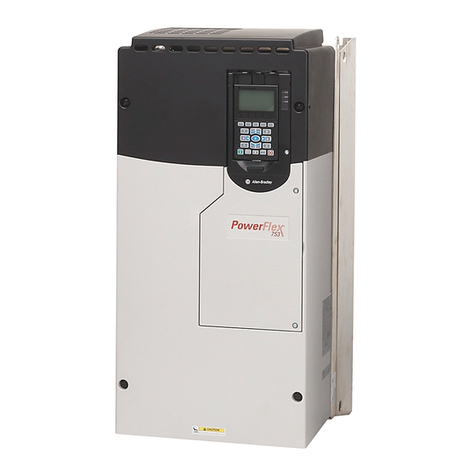
Allen-Bradley
Allen-Bradley PowerFlex 750 Series Programming manual
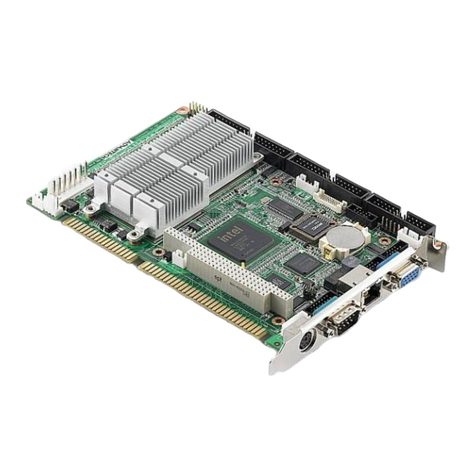
Advantech
Advantech PCA-6781 Startup manual
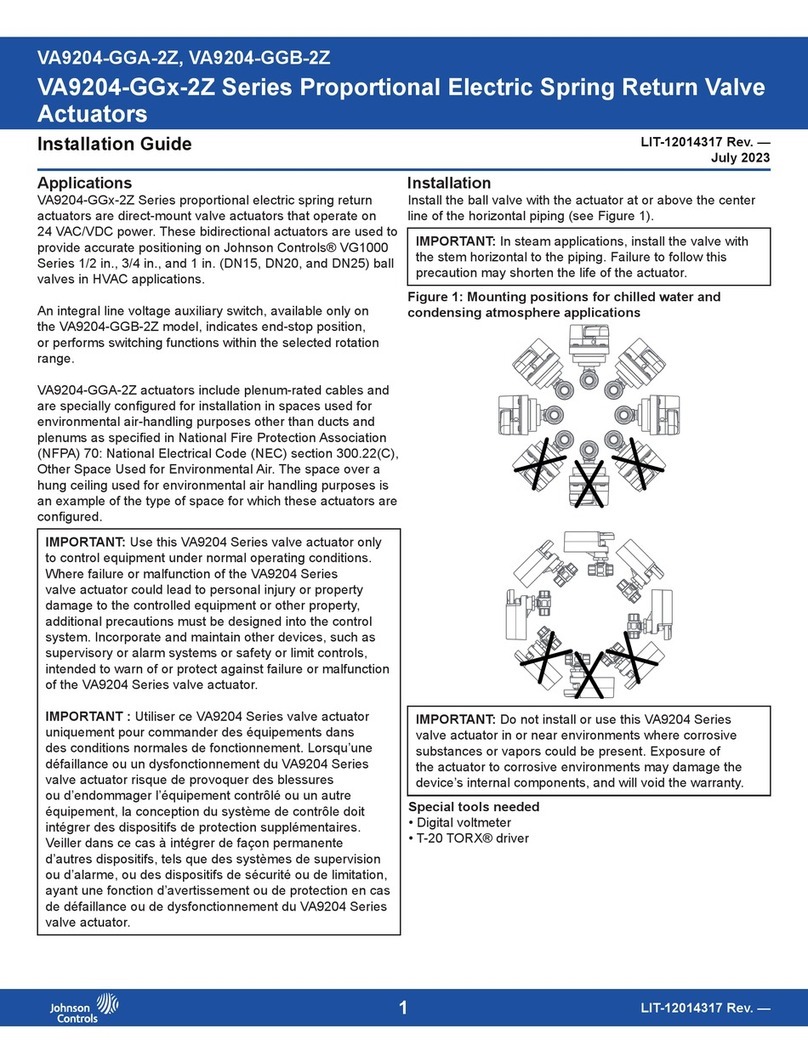
Johnson Controls
Johnson Controls VA9204-GG-2Z Series installation guide
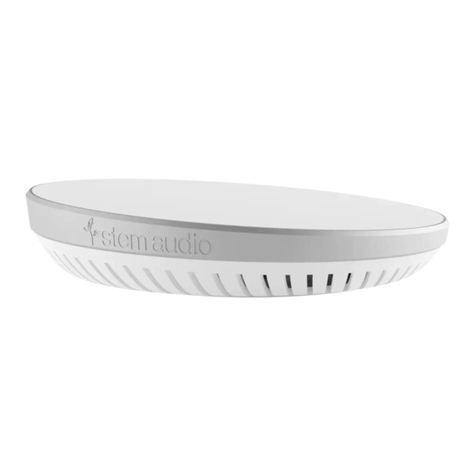
Shure
Shure STEM HUB EXPRESS user guide
